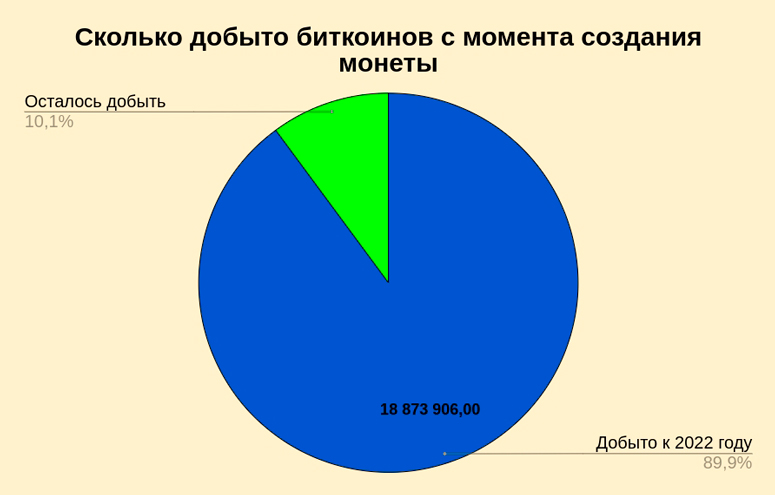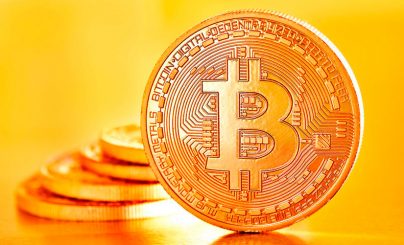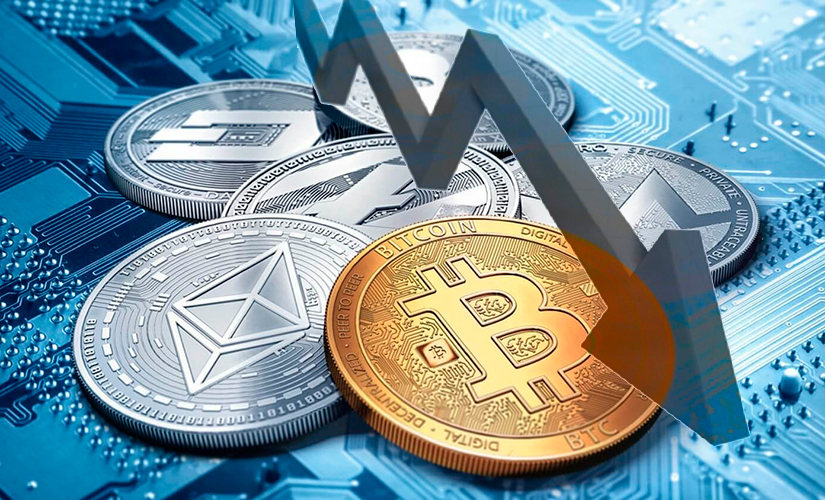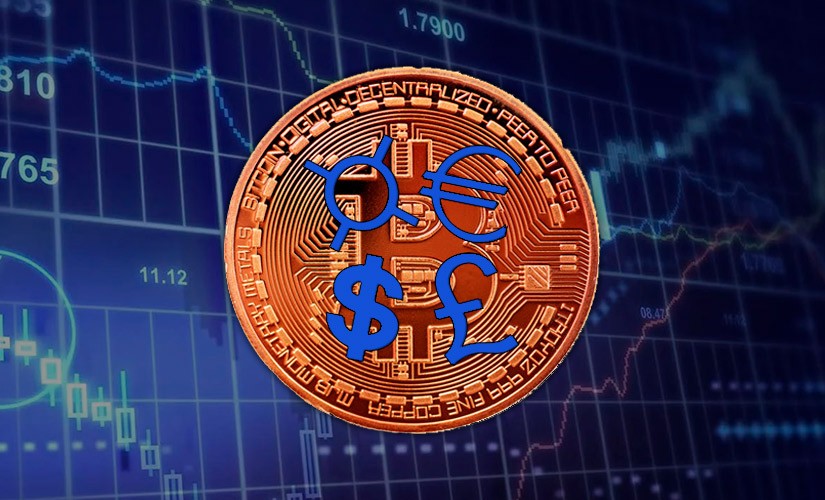2023. aasta alguse andmetel on üle 17 tuhande mündi ja märgid krüptoturul. Nad erinevad eesmärgi, konsensusalgoritmide, emiteerimise ja muude parameetrite poolest. Esimesel krüptovaluutal on eripära - bitcoinide arv on piiratud 21 miljoniga. See on projekti struktuuri sisse põimitud arendaja - Satoshi Nakamoto poolt. Kogukonnas selgitatakse erinevalt selle müntide arvu põhjust.
Kui palju on juba kaevandatud ja kui palju on veel kaevandamata BTC
Fiatraha peamine probleem on selle vastuvõtlikkus inflatsiooniprotsessidele. Aja jooksul väheneb raha ostujõud. Inflatsioon on normaalne protsess, mis aitab majandusel areneda. Selle optimaalne määr on kuni 6% aastas. Suure väärtusega inflatsioon võib hävitada riigi finantssüsteemi.
Fiatraha emiteerib valitsus institutsioonide - keskpanga ja teiste reguleerivate asutuste - abiga. Riigi raha emissioon ei ole piiratud. Riik võib trükkida nii palju raha kui vaja. Samal ajal langeb raha väärtus, sest selle taga ei ole midagi käegakatsutavat. Inflatsiooni vastu võitlemiseks võtab valitsus erinevaid meetmeid - vähendab intressimäära, viib läbi rahapoliitikat.
Satoshi Nakamoto võttis esimese krüptoraha väljatöötamisel arvesse majanduslikku komponenti. Väärtuse languse vastu võitlemiseks piiras ta bitcoinide arvu 21 miljoni mündiga. See on ebatäpne väärtus. Õige arv on 20 999 999 9796.
Bitcoini võrk kasutab Tööproovid konsensuse kinnitamise algoritm. Kaevurid teevad tööd - nad teevad matemaatikat. Kes iganes leidis hash väärtus saab esimesena õiguse lisada võrku veel ühe ploki. 2021. aasta lõpuks on juba kaevandatud 18 873 906 münti, mis on 90% emissioonist.
5020 $
boonus uutele kasutajatele!
ByBit pakub mugavaid ja turvalisi tingimusi krüptovaluutaga kauplemiseks, pakub madalaid vahendustasusid, kõrget likviidsust ja kaasaegseid vahendeid turuanalüüsiks. See toetab spot- ja finantsvõimendusega kauplemist ning aitab algajaid ja professionaalseid kauplejaid intuitiivse kasutajaliidese ja juhendmaterjalidega.
Teenida 100 $ boonust
uutele kasutajatele!
Suurim krüptovahetus, kus saate kiiresti ja turvaliselt alustada oma teekonda krüptovaluutade maailmas. Platvorm pakub sadu populaarseid varasid, madalaid vahendustasusid ja täiustatud vahendeid kauplemiseks ja investeerimiseks. Lihtne registreerimine, kiire tehingute kiirus ja usaldusväärne rahaliste vahendite kaitse teevad Binance'i suurepäraseks valikuks mis tahes taseme kauplejatele!
Ekspertide sõnul on 10-30% kaevandatud virtuaalsest rahast igaveseks kadunud. Krüptoraha on lukustatud rahakottidesse, mille võtmed kadusid ajal, mil bitcoin ei olnud nii populaarne ja inimesed ei realiseerinud oma rikkust. Rohkem kui 1 miljon BTC on salvestatud aadressile, mis kuulus salapärasele Satoshi Nakamotole. See on esimene kaevandaja, kes kaevandas vara, kui veel ei olnud suurt konkurentsi ja kõrgeid riistvaranõudeid.

Millal lõpeb müntide emissioon
Bitcoinide piiratud arv tähendab, et ühel hetkel kaevandatakse viimane BTC. Paljud inimesed mõtlevad: mis saab edasi. Kas plokiahelas lõpetatakse bitcoinide genereerimine?
Iga uus plokk kaevandatakse 10 minuti jooksul. See on sisseehitatud Bitcoini võrgu protokolli ja programmikoodi. Iga 4 aasta tagant makstakse kaevuritele tasu ploki kohta.(poolitamine) väheneb 2 korda. Selle aja jooksul saab kaevandada 210 tuhat münti.
Matemaatiliste arvutuste abil saame kuupäeva kaevandamine viimane plokk - 2140. Sellisel juhul kaevandatakse esimese 7 tsükli jooksul 99,2% bitcoini. Ülejäänud 100 aastat moodustavad vähem kui 1% krüptoraha.
Mis juhtub pärast viimase mündi kaevandamist
Kaevurid saavad oma töö eest tasu. 2009. aastal oli selle summa 50 BTC. Iga 4 aasta tagant poole võrra väheneb kaevurite sissetulek 2 korda. Aastal 2021 on tasu 6,25 BTC. Siiski on kaevandamine endiselt kasumlik, teenides tulu, mille aluseks on tasu kaevandatud ploki kohta.
Lisaks sellele maksavad kasutajad iga tehingu eest komisjonitasu. Selle suurus sõltub erinevatest teguritest ja seda saab määrata käsitsi. See on ka kaevandaja sissetulek tehingu plokki lisamise eest.
Viimane bitcoin kaevandatakse aastal 2140. Kaevandajad jätkavad siiski tehingute töötlemist ja saavad teenida tulu ülekandetasudest. Eeldusel, et bitcoini hind on kõrge, tasub see tegevus ära.
Poolitamine
Bitcoini võrgus hoiavad kaevurid Bitcoini võrku töös ja kaevandavad uusi münte. Satoshi Nakamoto lõi keerulise süsteemi, mis hõlmab tehingubloki kohta makstava tasu vähendamist 2 korda. See stimuleerib mündi kasvu, vähendades inflatsioonilist komponenti.
Bitcoin on tekkinud alternatiivina fiat mis võib lahendada traditsioonilise raha praegused probleemid.
Poolitamine on uute müntide kaevandamise määra vähenemine. Protsessiga kaasneb komisjonitasude vähenemine. Samal ajal väheneb kaevandajate tasu töö eest. Poolitamine toimub iga 210 tuhande kaevandatud ploki järel või umbes kord 4 aasta jooksul. 2023. aasta alguseks on tasu vähendatud juba neli korda.
| Kuupäev | Preemia (BTC) |
|---|---|
Järgmine auhinna jagamine toimub 2024. aasta mais. Kaevurid saavad 3,125 BTC.
Kui Nakamoto oleks määranud preemiaks 100 BTC, oleks bitcoinide lõplik arv 42 miljonit (kaks korda rohkem). Krüptovaluutade ajalugu oleks võinud kujuneda teisiti. Kuid arendaja ei valinud maksimaalset müntide arvu, vaid lähtus pigem kaevandamishüvitise suurusest.
Miks bitcoinide arv on piiratud 21 miljoniga
Esimest krüptoraha võrreldakse sageli väärismetallidega, mida nimetatakse digitaalseks kullaks. Samas tõmmatakse paralleele piiratud varudega. Kuld ja bitcoin on kallid, sest neid on vähe.
Erinevate krüptovaluutade arendajad on lubanud projektides piiratud emissiooni. Mõned BTC kahvlid on ka maksimaalne müntide arv 21 miljonit. On mitmeid teooriaid, miks Satoshi Nakamoto nii tegi. Arendaja ise ei selgitanud otsuse kohta midagi.
Üks variantidest hõlmab rahapakkumise asendamist. Nakamoto piiras bitcoinide pakkumist piiratud kogusega, lisades protokolli mehhanismi, mis suurendab müntide kaevandamise keerukust teatud ajavahemike järel. Arendaja plaan oli hoida vahetuskurssi madalal. Ja isegi suurendada seda aja jooksul.
Nakamoto kirjutas sellest Bitcoin Core'i liikmele Michael Hearnile. Arendaja tõi näite: kui 0,001 BTC väärtus on 1 euro, on terve mündi hind 1000 eurot. Selline kurss on saavutatud juba pikka aega.
Nakamoto tõi ka näite dollari rahapakkumise kohta. 2009. aastal oli maailmas $21 triljonit M1-formaadis (füüsilise raha kogusumma). Kui bitcoin saaks asendada kõik dollarid, oleks 1 BTC kohta $1 miljon. Ehk siis arendaja korjab kenasti väärtust. 2011. aastal lõpetas Nakamoto suhtlemise mõttekaaslastega ja kadus silmist. Tema kohta ei ole andmeid. Seetõttu on võimatu selgitada, miks ta sellise Bitcoini piiri valis.
Nõudlus ja pakkumine
On veel üks seletus, mis erineb M1 dollarite rahapakkumise asendamisest. See on seotud bitcoinide pakkumise ja nõudlusega. Programmi kood reguleerib kaevandamise keerukust, valides väärtuse nii, et iga ploki loomiseks kulub 10 minutit. Sellisel juhul ei mängi hashimise kiirus ja seadmete jõudlus rolli. Krüptoturu kujunemise alguses tehti kaevandamist nõrkades kodustes arvutites. Aastal 2023 kasutatakse BTC kaevandamiseks sadadest protsessoritest või videokaartidest koosnevaid farme. Samal ajal kulub ühe ploki loomiseks endiselt 10 minutit.
Niipea, kui maksimaalne bitcoini pakkumine läheneb oma tippväärtusele, toimub poole võrra vähenemine. Kaevandajad saavad 2 korda vähem tulu.
Poolitamise vahelisel perioodil õnnestub neil luua umbes 210 tuhat plokki. Iga 4-aastase tsükli jooksul saadakse kokku 100 BTC: 50 + 25 + 12,5 + 6,25 + 3,125 + 1,56 + 0,78 + 0,39 + 0,195 + ...... + 1 satoshi = 100. Kui 210 tuhat plokki korrutada 100 BTC suuruse preemiasummaga, saadakse maksimaalne müntide arv - 21 miljonit.
Fiatraha asendamine
Kes iganes Satoshi Nakamoto oli, kuid ta lõi krüptoraha mitte lõbu pärast. See on keeruline majanduslik ülesanne, mis põhineb matemaatilistel algoritmidel. Loomise eesmärk on asendada fiatraha. Neil on mitmeid puudusi, mida Nakamoto tahtis oma digitaalsete varade versioonis vältida:
- Tsentraliseeritud juhtimine.
- Piiramatu väljaandmine.
- Ekspositsioon inflatsioonile.
Bitcoini väljatöötamisel püüdis Nakamoto luua anonüümse, detsentraliseeritud rahaühiku, mis asendaks fiatraha. Ta kasutas traditsiooniliste finantsregulatsioonimehhanismide asemel krüptograafilisi meetodeid. Satoshi ei usaldanud pangandussüsteemi, mis võtab vastu hoiuseid ja annab laene. Samas ei ole tal piisavalt reserve, et maksta kõigile hoiustajatele korraga raha välja.
Arendaja piiras oma süsteemis olevate müntide arvu - kaevandada saab ainult 21 miljonit BTC. Pärast fiatraha asendamist bitcoinidega tekib puudus digitaalsetest varadest, nende kurss suureneb. Kui BTC hind jõuab $1 miljonini, on 1 satoshi võrdne 10 sendiga.
Muud teooriad Bitcoini loomiseks
Me võime vaid imestada, miks Nakamoto peatus täpselt 21 miljoni juures. Kas see on matemaatiline arvutus, majanduslik kasu või filosoofiline taust - keegi ei oska vastata. On erinevaid teooriaid, mille hulgas on üsna fantastilisi.
| Versioon | Kirjeldus |
|---|---|
| Psühholoogiline | Piirang suurendab huvi krüptoraha vastu, muudab selle väärtuslikumaks. |
| Bitcoin on kuld | BTC asendab väärismetalli kui investeerimisvahendi. Krüptoraha emissioon on piiratud, nagu ka kullavarud. |
| Inflatsiooniline | Omamoodi "lagi" müntide arvule võimaldab võidelda vara hinna langusega. Keegi ei saa kaevandada rohkem bitmünte, kui arendaja on programmi koodi pannud. |
| Numbri ilu | Nakamoto kirjutas valiku keerukusest. Satoshi mõistis, et tuleb teha otsus, mis põhineb isiklikul ilumeelel. |
Võib-olla on kõigis versioonides osa tõde ja Nakamoto lähenes sellele küsimusele terviklikult, võttes arvesse kõiki nüansse. Siiski on Ethereum - teine kõige kapitaliseeritud krüptoraha 2021. aastal - kasvas kiiremini kui teised digitaalsed varad. ETH emissioon ei ole piiratud piiratud väärtusega. Seetõttu tundub versioon nõudluse kunstlikust tekitamisest kiiruse suurendamiseks esialgu ebaveenev.
Korduma kippuvad küsimused
📉 Kuna kaevandamise keerukus suureneb, peaks BTC hind proportsionaalselt tõusma. Miks see perioodiliselt langeb?
Krüptovaluutade kurss sõltub paljudest teguritest: uudiste taustast, poliitilistest sündmustest, majandusest globaalsel tasandil jne.
❓ Miks BTC ei ole veel asendanud fiat'i?
Traditsiooniline finantsvõrgustik on keeruline mitmetasandiline süsteem, mis hõlmab erinevaid riiklikke ja ülemaailmseid institutsioone. Fiatraha ei saa lihtsalt kaotada ja selle asemel bitcoin'i vastu võtta. Eriti kuna riigid suhtuvad krüptoraha suhtes erinevalt.
📊 Kui Ethereum ei piira müntide emiteerimist, siis kuidas ta võitleb inflatsiooni vastu?
2021. aasta augustis toimus Londoni värskendus, mis sisaldab mündi põletamise mehhanismi. Ringlusest võetakse välja rohkem varasid kui lisatakse.
❔ Kui realistlik on $1 miljoni BTC määr, otsustades 2021. aasta olukorra üle - kas see on kättesaamatu näitaja?
Krüptovaluutad on väga volatiilne instrument. Raske on teha prognoose ja olla seotud kindla arvu ja kuupäevaga. Sellised versioonid on olemas, sealhulgas tuntud krüptoinvestoritelt, rahastajatelt.
❌ Miks ei püüa keegi leida juurdepääsu vanadele rahakottidele, kus on miljoneid münte?
Selliste otsingute kohta puudub teave. Kaasaegse arvutitehnika abil on võimatu leida aadressile juurdepääsuks privaatseid võtmeid.
Kas tekstis on viga? Märkige see hiirega ja vajutage Ctrl + Sisestage.
Autor: Saifedean Ammous, krüptorahanduse ekspert.















